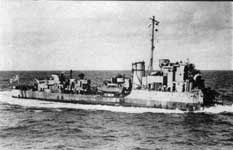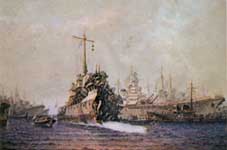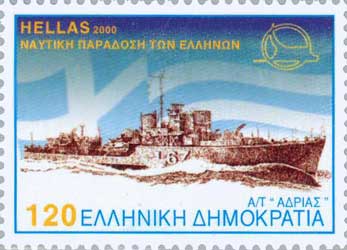.

Adrias (L67)
| Career | |
|---|---|
| Ordered: | |
| Laid down: | May 1, 1941 |
| Launched: | February 3, 1942 |
| Commissioned: | July 20, 1942 |
| Decommissioned: | 1945 |
| Fate: | returned to UK and sold for scrap |
| Current position: | |
| General Characteristics | |
| Displacement: | Full load 1,490 tons, standard displacement 1,050 tons |
| Length: | 85.3 m (279.85 ft)(Over All) |
| Beam: | 11.4 m (37.40 ft) |
| Draft: | 2.4 m (7.87 ft) |
| Speed: | Maximum Speed 26.0 knots |
| Complement: | 170 men |
| Armament: | Four 101.6 mm (4") (4x101.6) guns (2 turrets ×2)(one turret fore and one aft), one quadruple 40 mm (1.57") 2pdr pompom gun , three 20mm (0.79") Anti Aircraft guns, two 533mm (21") torpedo tubes ,one depth charge track |
| Powerplant: | Boilers: 2 Admiralty 3 drum boilers, Engines: 2 shaft Parsons turbine, Shafts: 2 (twin screw ship), Power: 19,000 shp, (14.2 MW), Range: 2,350 nautical miles (4,352 km) at 20.0 knots (37.0 km/h) |
| Armour: | |
Adrias (Greek Αδρίας) was a Hunt class destroyer that was originally built for Royal Navy as HMS Border (L67) but never commissioned. Before her completion, she was loaned to Royal Hellenic Navy on July 20, 1942 and commissioned as Adrias (L67) on August 5, 1942 in order to relieve heavy losses of ships sustained by the Royal Hellenic Navy during the German invasion of 1941 and throughout the war. Adrias took her name from an ancient Greek town in Italy near the Po river (Herodotus vi. 127, vii. 20, ix. 92; Euripides, Hippolytus, 736).
Command of Adrias was accepted by Cdr. J. Toumbas in Newcastle, England on July 20 1942. Upon completion of the training period on August 26, while sailing under foggy conditions with only the left engine functioning, she ran aground near Scapa Flow. It took four months to repair. No responsibility was attributed to the captain for the accident. In the beginning of January, 1943, after the completion of repairs, Adrias sailed to the Mediterranean where she participated in missions escorting convoys.
On January 27, 1943, while positioned 360 miles NW off Cape Finisterre Adrias was believed to have sunk the German U/Boat U-553 (British Admiralty's signal presumed her possibly sunk). When the war ended the loss of the German submarine was officially confirmed to have occurred on January 27. However, the name of the ship that caused the sinking was not mentioned. During that same operation on February 13, 1943, Adrias sunk or seriously damaged the U/Boat U-623 (the last report from that submarine was dated February 9, 1943).
Adrias took part in numerous convoy escorts in the Mediterranean Sea as well as in the Sicily landing operations where on the night of July 20, 1943, in cooperation with British destroyer HMS Quantock (L58) she successfully confronted 3 torpedo boats during a night engagement and sunk two of them. On September 20, 1943, the Taranto based Italian Fleet sailing towards Malta, surrendered to a force of 4 ships, including Adrias.

Adrias (L-67) after being struck by a German mine on October 22, 1943
On October 22, 1943 during operations in the Dodecanese Islands and while near the island of Kalymnos with the British destroyer HMS Hurworth (L28), Adrias struck a mine. From the explosion, her bow was torn off. The English Flotilla Commander onboard Hurworth ordered Cdr. Toumbas to abandon ship. Hurworth, while trying to come to Adrias's rescue, also hit a mine and sunk taking with her 143 men. In spite of the damage suffered, Adrias took survivors of Hurworth (among them her CO) and managed to reach the nearby coast of Gümüşlük in neutral Turkey with 21 men of her crew dead and 30 wounded. After some minor repairs, the ship sailed on December 1, 1943 despite her missing bow, for Alexandria, Egypt. After a trip of 730 nautical miles 300 of them in the range of Luftwaffe's Junkers Ju 88 bombers based in occupied Greece, (the threat of them forced her to sail only at at night despite her limited manoeuvrability), she managed to reach Alexandria on December 6 (day of Feast of St. Nicholas, patron saint of seamen in Greece) where she was enthusiastically greeted by the British Fleet and other allied ships. This achievement was considered a brilliant example of seamanship, and provided a morale boost to the Royal Hellenic Navy and other allied ships in the Mediterranean Sea.

Adrias (L-67) entering Alexandria port on December 6, 1943, painting by A. Kanas
After the liberation of Greece from the Germans, Adrias, with her bow temporarily repaired, arrived in Faliro with the rest of the ships of the Hellenic Fleet. The ship was never fully repaired due to the termination of war operations in the Mediterranean and sailed to England where she was returned to the Royal Navy. Of the same class of ships serving in the Hellenic Navy were: Adrias (DO6) formerly HMS Tanatside (L69) (loaned to Hellenic Navy as a replacement of this ship), Hastings formerly HMS Catterick (L81) loaned to Hellenic Navy in 1946, Kanaris built as HMS Hatherleigh (L53) , Miaoulis built as HMS Modbury (L91), Pindos built as HMS Bolebroke (L65).

Greek destroyer Adrias, Stamp
The Hellenic Navy gave the same name to commemorate this ship to Standard type frigate Adrias (F459) in 1994.
Links
| Ancient Greece
Science, Technology , Medicine , Warfare, , Biographies , Life , Cities/Places/Maps , Arts , Literature , Philosophy ,Olympics, Mythology , History , Images Medieval Greece / Byzantine Empire Science, Technology, Arts, , Warfare , Literature, Biographies, Icons, History Modern Greece Cities, Islands, Regions, Fauna/Flora ,Biographies , History , Warfare, Science/Technology, Literature, Music , Arts , Film/Actors , Sport , Fashion --- |
Retrieved from "http://en.wikipedia.org/"
All text is available under the terms of the GNU Free Documentation License

